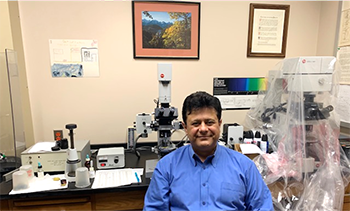SAGE Record 051, Seyedolali et al.
Seyedolali, A., E. J. Torres-Parada, K. Rottmann, and W. Full, 2022, Oklahoma saline reservoirs for Carbon Capture, Utilization, and Storage (CCUS): SAGE Record 051, 11 p., <http://sagetech.org/sage_record_051_seyedolali_et_al/>. Oral presentation at SAGE 2022, 23–25 March, Lafayette, Louisiana, and Virtual.
Oklahoma Saline Reservoirs for Carbon Capture, Utilization, and Storage (CCUS)
Seyedolali, Abbas (Oklahoma Geological Survey/University of Oklahoma, Norman, OK/GXStat, LLC, Wichita, KS), Emilio J. Torres-Parada (OGS/OU), Kurt Rottmann (RKR Services Company, LLC, Bethany, OK), and William Full (GXStat, LLC, Wichita, KS)

Reduction of anthropogenic carbon dioxide (CO2) emissions is an important endeavor that can mitigate climate change. Carbon Capture, Utilization, and Storage (CCUS) has received considerable attention and is poised as a new avenue of research and development. In the state of Oklahoma there are many possible reservoirs for CCUS, but for some reservoirs hydraulic fracturing and disposal water injections have variously impacted the potential for safe CCUS development. Importantly, there are induced seismic hazards within and around reservoirs already developed for petroleum production or waste-water disposal.
One of the most important hosts of saline reservoirs in Oklahoma is the Ordovician Arbuckle Group. We are in the process of investigating whether produced reservoirs within the Arbuckle Group have sustained damage from hydraulic fracturing or wastewater injection that render them unsuitable for CCUS. We have concluded, based on our analyses, that there are Arbuckle reservoirs that may be suitable and there are those that may not be suitable based upon internal and external characteristics such as depositional history, fluid migration, diagenesis, and cap rock integrity. We are also attempting to define other horizons that have potential for CCUS.
We have selected Oklahoma counties, seven thus far, where the saline reservoirs have the desired characteristics for CCUS, including seals with the necessary capillary pressure capacity, mechanical integrity, and geometric closure. There are two primary risks in these new reservoirs we are assessing. In the areas where the base seal is absent or the seal is near sub-reservoir faults, CO2 injection could affect the basement rocks; therefore, we are modeling the impact of CCUS in these cases in damaging lower horizons. A second risk involves the formation of acidic brine which could dissolve the caprock and compromise containment.
These new saline reservoirs are contained in the Ordovician Simpson Group, Upper Ordovician–Lower Devonian Hunton dolomite in the Arkoma Basin, Pennsylvanian Morrowan age rocks (Cromwell sand), Mississippian Chat, and possibly the deeper, unaltered Arbuckle Group in the Anadarko and Arkoma basins. These prospective reservoirs were selected based on reservoir geometry and characteristics defined by well logs, cores, well cuttings, mercury injection capillary pressure (MICP), thin sections, and electron microprobe analyses (EPMA).
Economic considerations and public and governmental acceptance are additional important considerations in this process that needs to be carefully examined. The available federal 45Q tax credit makes it an attractive process for the companies to get involved, which can lead to viable and economically sound projects that can be implemented in a relatively short time.

